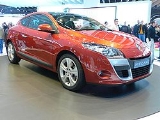
Renault Mégane
Encyclopedia
The Renault Mégane is a small family car produced by the French
automaker Renault
since 1995. It is offered in 3- and 5-door hatchback
, saloon, coupé
, convertible
and estate bodystyles. The Renault Scénic
(launched 1996) is the first modern compact MPV
to be built in Europe
, and is based on the Mégane floorpan.
. The car was essentially a reskin of its predecessor, and carried over the 19's floorpan, engine
s, transmissions and chassis design, albeit with much modification. Taking its name from a Renault concept car shown in 1988, the Mégane further developed the new corporate styling theme introduced by Patrick Le Quément on the Laguna
, most notably the "bird-beak" front grille - a styling cue borrowed from the Renault 16
of the 1960s. As with the 19 and the 11
before it, the Mégane was produced in Renault's Douai
plant in northern France, and in the Spanish plant of Palencia
.
Safety was a key focus of the Megane I, Renault's first car reflecting their new focus of selling on safety. It featured a pillar-mounted 3-point seatbelt for the middle-rear occupant (replacing the common 'lap strap'), standard front belt pre-tensioners and load limiters, driver's airbag and an impressive safety structure - a specification ahead of most rivals in 1995. Some features, such as the 3-point middle belt, had debuted on the Renault 19 safety concept vehicle (and in fact this feature entered production on the Renault Laguna before the Megane). The car also benefited from Renault's first "System for Restraint and Protection" (SRP), essentially a system of careful optimisation of occupant restraint by interaction of the seat, seatbelt, pretensioner, load limiter and airbag. Megane I achieved a best-in-class 4-star crash test rating in the 1998 round of testing by Euro NCAP.
1996 saw the introduction of the Mégane Scénic compact MPV
.
Power came from the Renault E-type ("Energy") engine in 1.4 L, 1.6 L, 1.8 L, and the F-type unit in both 1.9 L diesel and 2.0 L petrol form, although this time around there was a wider variety of 16-valve derivatives. A 1.9 L diesel engine
in both normally aspirated and turbocharged forms was also available.
Renault also produced a limited number of Renault sport edition phase 1's with the Renaultsport bodywork, however these were very rare. The Renaultsport kit was available to purchase for a short time direct from Renault France, but has now been discontinued, thus their value has increased. The trim specification levels were: RN, RT and RXE.
engines were used across the range. The production continued for the Latin America Market, where it was sold alongside the Megane II line at a considerably lower price until 2008.
, the original Megane is still available since 2002, but now sold only as a sedan. It features the LA04 engine (16 valve, 1.6 litres and 110 HP), and is produced by both Renault Colombia and Argentina, in where it is one of the best-selling cars to date. It is a car with more advanced safety features, upgraded equipment and more. The Mégane I costs less than the Mégane II. Both remain available. Up until 2009, it was sold in Argentina
and Colombia
.
Trim specification levels
The following specification levels cover the Hatchback only. Estate, Classic (sedan), Coupe and Cabriolet had slightly different trim specification levels.
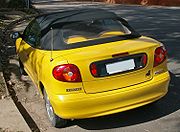
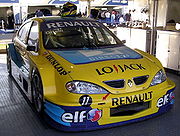
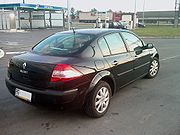
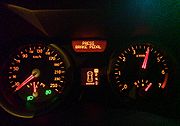 The Mégane II was launched in September 2002, and marked a completely fresh start. The two cars bear very little resemblance, the new vehicle having been inspired by the manufacturer's new design language first seen in the Avantime
The Mégane II was launched in September 2002, and marked a completely fresh start. The two cars bear very little resemblance, the new vehicle having been inspired by the manufacturer's new design language first seen in the Avantime
. The new Mégane was voted European Car of the Year
for 2003, fighting off stiff competition from Japan's
Mazda 6 and PSA's
Citroën C3
, and achieved a 5-star safety rating in the EuroNCAP
crash tests, the first small family car to do so.
Mégane II and the Laguna were both showcases for a great deal of innovative technologies Renault launched at the beginning of the 2000s; the Renault Card keyless ignition system, standard on the Mégane II, was a first in this class and has since been widely adopted. Similarly, the option of a panoramic glass sunroof is another area in which Renault led where others followed.
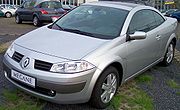 In Brazil, Renault launched a flex-fuel version, called "Hi-Flex", which is able to run either with unleaded gasoline (petrol) or ethanol. Like the Brazilian Scénic and Clio versions, the Mégane's engine can work with any mix of gasoline and ethanol, due to the use of an electronic control module. The flex version has a 16V 109 hp (110 PS) (113 hp (115 PS) with ethanol) 1.6-litre inline-four engine developed and produced in Brazil, but the 2.0-litre version does not allow ethanol use, because its engine is made in France.
In Brazil, Renault launched a flex-fuel version, called "Hi-Flex", which is able to run either with unleaded gasoline (petrol) or ethanol. Like the Brazilian Scénic and Clio versions, the Mégane's engine can work with any mix of gasoline and ethanol, due to the use of an electronic control module. The flex version has a 16V 109 hp (110 PS) (113 hp (115 PS) with ethanol) 1.6-litre inline-four engine developed and produced in Brazil, but the 2.0-litre version does not allow ethanol use, because its engine is made in France.
As with the previous Mégane, the range of models is wide; there is a three and five door hatchback available, named "Sport Hatch" and "Hatch" respectively, there is a 4-door saloon/sedan (Sport Saloon), a five-door estate (Sport Tourer / Grandtour), and to replace both the Mégane Coupe and Convertible, a new retractable hardtop coupe designed by Karmann
.
competes in the hot hatch
segment of the market.
B16 is based on the 2006 platform of the Renault Meganes bicorp.
, being the nation's fourth most popular car in 2005 and fifth most popular in 2004 and 2006. In 2007, however, it dipped to eighth place with just over 55,000 examples being sold.
breakdown statistics, the Megane scored very well, surpassing such cars as the Ford Focus, Honda Civic
and Opel/Vauxhall Astra
. The 2008 model achieved third place in its class after the BMW 1 and Audi A3.
In September 2008, both the Renault Mégane Berline 5-door hatchback
& Mégane Coupé
were presented officially. The two models feature quite a different design, the Coupé having a very aggressive and sporty design while the 5-door model is more conservative. In this generation, no automatic transmission
is offered, replaced by a continuously variable transmission
. The Coupé can be considered as a shooting brake due to its coupé-like design.
The phase I version of Megane II was well known for reliability issues, especially with the engine management system. Renault has now spent much more time and mileage testing the new model which is therefore expected to have improved reliability.
Braking system: ABS Bosch 8.0 (TEVES MK60 for RS version), Electronic brake distribution, Braking Assistance System are standard.
Wheels and tyres (standard):
Weight:
will build and maintain.
France
The French Republic , The French Republic , The French Republic , (commonly known as France , is a unitary semi-presidential republic in Western Europe with several overseas territories and islands located on other continents and in the Indian, Pacific, and Atlantic oceans. Metropolitan France...
automaker Renault
Renault
Renault S.A. is a French automaker producing cars, vans, and in the past, autorail vehicles, trucks, tractors, vans and also buses/coaches. Its alliance with Nissan makes it the world's third largest automaker...
since 1995. It is offered in 3- and 5-door hatchback
Hatchback
A Hatchback is a car body style incorporating a shared passenger and cargo volume, with rearmost accessibility via a rear third or fifth door, typically a top-hinged liftgate—and features such as fold-down rear seats to enable flexibility within the shared passenger/cargo volume. As a two-box...
, saloon, coupé
Coupé
A coupé or coupe is a closed car body style , the precise definition of which varies from manufacturer to manufacturer, and over time...
, convertible
Convertible
A convertible is a type of automobile in which the roof can retract and fold away having windows which wind-down inside the doors, converting it from an enclosed to an open-air vehicle...
and estate bodystyles. The Renault Scénic
Renault Scénic
The Renault Scénic is a compact MPV produced by French automaker Renault, the first to be labelled as such in Europe. It is based on the chassis of the Mégane small family car. It became 1997 European Car of the Year on its launch in late 1996...
(launched 1996) is the first modern compact MPV
Compact MPV
A compact MPV is a car classification used in Europe to describe multi-purpose vehicle versions of small family cars , fitting between the mini MPV and large MPV sub-segments...
to be built in Europe
Europe
Europe is, by convention, one of the world's seven continents. Comprising the westernmost peninsula of Eurasia, Europe is generally 'divided' from Asia to its east by the watershed divides of the Ural and Caucasus Mountains, the Ural River, the Caspian and Black Seas, and the waterways connecting...
, and is based on the Mégane floorpan.
Mégane I (1995–2002)
The Mégane I was unveiled in the autumn of 1995, as a replacement of the Renault 19Renault 19
The Renault 19 is a small family car that was produced by the French car manufacturer Renault between 1988 and 2000.-Overview:The R19 was launched on September 1988 as the replacement for the 9 and 11, both of which were ageing and outdated by the late 1980s...
. The car was essentially a reskin of its predecessor, and carried over the 19's floorpan, engine
Engine
An engine or motor is a machine designed to convert energy into useful mechanical motion. Heat engines, including internal combustion engines and external combustion engines burn a fuel to create heat which is then used to create motion...
s, transmissions and chassis design, albeit with much modification. Taking its name from a Renault concept car shown in 1988, the Mégane further developed the new corporate styling theme introduced by Patrick Le Quément on the Laguna
Renault Laguna
The Renault Laguna is a large family car produced by the French manufacturer Renault. The first Laguna was launched in 1993, the second generation was launched in 2000, and the third generation was made available for sale in October 2007....
, most notably the "bird-beak" front grille - a styling cue borrowed from the Renault 16
Renault 16
The Renault 16 is a hatchback produced by French automaker Renault between 1965 and 1980 in Le Havre, France. The reviewer in the May 1965 edition of the English "Motoring Illustrated" said: "The Renault Sixteen can thus be described as a large family car but one that is neither a four door saloon...
of the 1960s. As with the 19 and the 11
Renault 9/11
The Renault 9 and Renault 11 are two small family cars produced by the French manufacturer Renault for model years 1981-1988 in sedan and hatchback configurations — both styled by prominent French automobile designer, Robert Opron.Variants were manufactured by American Motors, as the...
before it, the Mégane was produced in Renault's Douai
Douai
-Main sights:Douai's ornate Gothic style belfry was begun in 1380, on the site of an earlier tower. The 80 m high structure includes an impressive carillon, consisting of 62 bells spanning 5 octaves. The originals, some dating from 1391 were removed in 1917 during World War I by the occupying...
plant in northern France, and in the Spanish plant of Palencia
Palencia
Palencia is a city south of Tierra de Campos, in north-northwest Spain, the capital of the province of Palencia in the autonomous community of Castile-Leon...
.
Safety was a key focus of the Megane I, Renault's first car reflecting their new focus of selling on safety. It featured a pillar-mounted 3-point seatbelt for the middle-rear occupant (replacing the common 'lap strap'), standard front belt pre-tensioners and load limiters, driver's airbag and an impressive safety structure - a specification ahead of most rivals in 1995. Some features, such as the 3-point middle belt, had debuted on the Renault 19 safety concept vehicle (and in fact this feature entered production on the Renault Laguna before the Megane). The car also benefited from Renault's first "System for Restraint and Protection" (SRP), essentially a system of careful optimisation of occupant restraint by interaction of the seat, seatbelt, pretensioner, load limiter and airbag. Megane I achieved a best-in-class 4-star crash test rating in the 1998 round of testing by Euro NCAP.
1996 saw the introduction of the Mégane Scénic compact MPV
Compact MPV
A compact MPV is a car classification used in Europe to describe multi-purpose vehicle versions of small family cars , fitting between the mini MPV and large MPV sub-segments...
.
Power came from the Renault E-type ("Energy") engine in 1.4 L, 1.6 L, 1.8 L, and the F-type unit in both 1.9 L diesel and 2.0 L petrol form, although this time around there was a wider variety of 16-valve derivatives. A 1.9 L diesel engine
Diesel engine
A diesel engine is an internal combustion engine that uses the heat of compression to initiate ignition to burn the fuel, which is injected into the combustion chamber...
in both normally aspirated and turbocharged forms was also available.
Renault also produced a limited number of Renault sport edition phase 1's with the Renaultsport bodywork, however these were very rare. The Renaultsport kit was available to purchase for a short time direct from Renault France, but has now been discontinued, thus their value has increased. The trim specification levels were: RN, RT and RXE.
Mégane I Facelift (1999–2002)
A mild facelift in spring 1999 gave the Mégane I a modified grille, more advanced safety features and upgraded equipment, and 16-valveMulti-valve
In automotive engineering a multi-valve or multivalve engine is one where each cylinder has more than two valves. A multi-valve engine has better breathing and can operate at higher revolutions per minute than a two-valve engine, delivering more power.- Multi-valve rationale :A multi-valve design...
engines were used across the range. The production continued for the Latin America Market, where it was sold alongside the Megane II line at a considerably lower price until 2008.
Mégane in Venezuela, Argentina and Colombia
In VenezuelaVenezuela
Venezuela , officially called the Bolivarian Republic of Venezuela , is a tropical country on the northern coast of South America. It borders Colombia to the west, Guyana to the east, and Brazil to the south...
, the original Megane is still available since 2002, but now sold only as a sedan. It features the LA04 engine (16 valve, 1.6 litres and 110 HP), and is produced by both Renault Colombia and Argentina, in where it is one of the best-selling cars to date. It is a car with more advanced safety features, upgraded equipment and more. The Mégane I costs less than the Mégane II. Both remain available. Up until 2009, it was sold in Argentina
Argentina
Argentina , officially the Argentine Republic , is the second largest country in South America by land area, after Brazil. It is constituted as a federation of 23 provinces and an autonomous city, Buenos Aires...
and Colombia
Colombia
Colombia, officially the Republic of Colombia , is a unitary constitutional republic comprising thirty-two departments. The country is located in northwestern South America, bordered to the east by Venezuela and Brazil; to the south by Ecuador and Peru; to the north by the Caribbean Sea; to the...
.
Trim specification levels
The following specification levels cover the Hatchback only. Estate, Classic (sedan), Coupe and Cabriolet had slightly different trim specification levels.
- Freeway: Authentique, Expression, Expression Plus
- Sport: Sport, Dynamique, Dynamique Plus
- Elegance: Privilege, Privilege Plus
Engine options


| Model | Displacement (cc) | Power | Top Speed | 0–100 km/h(s) |
|---|---|---|---|---|
| 1.4 Eco 8v | 1390 | 70 PS | 168 km/h (104 mph) | 14.5 |
| 1.4 8v | 1390 | 75 PS | 170 km/h (106 mph) | 14.3 |
| 1.4 8v | 1390 | 75 PS | 170 km/h (106 mph) | 13.8 |
| 1.4 16v | 1390 | 95 PS | 184 km/h (114 mph) | 11.8 |
| 1.6 8v | 1598 | 75 PS | 175 km/h (109 mph) | 12.9 |
| 1.6 8v | 1598 | 90 PS | 184 km/h (114 mph) | 11.5 |
| 1.6 16v | 1598 | 109 PS | 195 km/h (121 mph) | 9.8 |
| 1.8 16v | 1783 | 115 PS | 199 km/h (124 mph) | 9.0 |
| 2.0 8v | 1998 | 113 PS | 197 km/h (122 mph) | 9.7 |
| 2.0 16v | 1998 | 150 PS | 215 km/h (134 mph) | 8.6 |
| 2.0 16v IDE Gasoline direct injection In internal combustion engines, gasoline direct injection , also known as petrol direct injection or direct petrol injection, is a variant of fuel injection employed in modern two-stroke and four-stroke gasoline engines... |
1998 | 140 PS | 213 km/h (132 mph) | 8.6 |
| 1.9 8v D | 1870 | 65 PS | 160 km/h (99 mph) | 16.5 |
| 1.9 8v D | 1870 | 65 PS | 158 km/h (98 mph) | 17.9 |
| 1.9 8v dT | 1870 | 95 PS | 180 km/h (112 mph) | 12.3 |
| 1.9 8v dTi | 1870 | 100 PS | 183 km/h (114 mph) | 12.3 |
| 1.9 8v dTi | 1870 | 80 PS | 170 km/h (106 mph) | 13.8 |
| 1.9 8v dCi | 1870 | 102 PS | 188 km/h (117 mph) | 11.5 |
| 1.9 8v dCi | 1870 | 90 PS | 174 km/h (108 mph) | 12.9 |
Mégane II (2002–2008)


Renault Avantime
The Renault Avantime is a grand-touring coupé combining features of a 2+2 coupé and an MPV — marketed by the French manufacturer Renault, designed and manufactured by Matra, between 2001 and 2003...
. The new Mégane was voted European Car of the Year
European Car of the Year
The European Car of the Year award was established in 1964 by a collective of automobile magazines from different countries in Europe. The current organisers of the award are Auto , Autocar , Autopista , Autovisie , L'Automobile Magazine , Stern and Vi Bilägare .The voting jury consists of motoring...
for 2003, fighting off stiff competition from Japan's
Japan
Japan is an island nation in East Asia. Located in the Pacific Ocean, it lies to the east of the Sea of Japan, China, North Korea, South Korea and Russia, stretching from the Sea of Okhotsk in the north to the East China Sea and Taiwan in the south...
Mazda 6 and PSA's
PSA Peugeot Citroën
PSA Peugeot Citroën is a French manufacturer of automobiles and motorcycles sold under the Peugeot and Citroën marques. Headquartered in the 16th arrondissement of Paris, PSA is the second largest automaker based in Europe and the number eight in the world.-History:In December 1974 Peugeot S.A....
Citroën C3
Citroën C3
The Citroën C3 is a supermini car equipped with a range of inline-four engines that has been produced by the French automaker Citroën since 2002. It was designed by Donato Coco and Jean-Pierre Ploué, previously known for designing the first generation Renault Twingo; the former has been the head of...
, and achieved a 5-star safety rating in the EuroNCAP
EuroNCAP
The European New Car Assessment Programme is a European car safety performance assessment programme based in Brussels and founded in 1997 by the Transport Research Laboratory for the UK Department for Transport and backed by several European governments.-History and activities:Euro NCAP is a...
crash tests, the first small family car to do so.
Mégane II and the Laguna were both showcases for a great deal of innovative technologies Renault launched at the beginning of the 2000s; the Renault Card keyless ignition system, standard on the Mégane II, was a first in this class and has since been widely adopted. Similarly, the option of a panoramic glass sunroof is another area in which Renault led where others followed.

As with the previous Mégane, the range of models is wide; there is a three and five door hatchback available, named "Sport Hatch" and "Hatch" respectively, there is a 4-door saloon/sedan (Sport Saloon), a five-door estate (Sport Tourer / Grandtour), and to replace both the Mégane Coupe and Convertible, a new retractable hardtop coupe designed by Karmann
Karmann
Wilhelm Karmann GmbH, commonly known simply as Karmann, in Osnabrück, Germany was until 2009 the largest independent motor vehicle manufacturing company in Germany...
.
Mégane RS
RenaultSport (RS) versions of the 3-door and 5-door hatchbacks were introduced, equipped with a turbocharged petrol 2.0 L 16v engine producing 225 PS. Along with the engine, changes were made to the front and rear suspension geometry to improve handling, and the model features a deeper, wider front bumper. The Mégane Renault SportMégane Renault Sport
The Mégane Renaultsport or Mégane RS is a series of hot hatch models based on Renault Mégane, designed and built by French automaker Renault since 2004.-Mégane II Renaultsport:The RS is based on the Renault Mégane II small family car....
competes in the hot hatch
Hot hatch
Hot hatch was originally an informal automotive industry term, shortened from hot hatchback, initially coined by the British motoring press in 1984, for a high-performance derivative of a car body style consisting of a three- or five-door hatchback automobile.Vehicles of this class are based on...
segment of the market.
Mégane II Facelift (2006–2008)
The model was revised in 2006, with changes in interior trim, specification levels and most notably, a new front nose. A new front suspension system borrowed from the Mégane 2.0 225 PS was adopted, improving the driving performance. Also, the Nissan SentraNissan Sentra
The Nissan Sentra is a compact car produced by automaker Nissan Motors and is generally a rebadged export version of the Japanese Nissan Sunny. The name "Sentra" is not used in Japan....
B16 is based on the 2006 platform of the Renault Meganes bicorp.
Engines
| Model | Displacement (cc) | Power | Top Speed | 0–100 km/h(s) |
|---|---|---|---|---|
| 1.4 16v Mk 2 | 1390 | 80 PS | 170 km/h (106 mph) | 13.5 |
| 1.4 16v Mk 2 | 1390 | 98 PS | 183 km/h (114 mph) | 12.5 |
| 1.6 16v Mk 2 | 1598 | 116 PS | 195 km/h (121 mph) | 10.8 |
| 2.0 16v Mk 2 | 1998 | 136 PS | 205 km/h (127 mph) | 9.6 |
| 2.0 16v Turbo Mk 2 | 1998 | 165 PS | 220 km/h (137 mph) | 8.3 |
| 2.0 16v Turbo RenaultSport Mk 2 | 1998 | 225 PS | 236 km/h (147 mph) | 6.5 |
| 1.5 8v dCi Mk 2 | 1461 | 80 PS | 170 km/h (106 mph) | 14.3 |
| 1.5 8v dCi facelift Mk 2 | 1461 | 86 PS | 174 km/h (108 mph) | 12.7 |
| 1.5 8v dCi Mk 2 | 1461 | 100 PS | 181 km/h (112 mph) | 12.8 |
| 1.5 8v dCi facelift Mk 2 | 1461 | 106 PS | 185 km/h (115 mph) | 11.1 |
| 1.9 8v dCi Mk 2 | 1870 | 120 PS | 196 km/h (122 mph) | 10.5 |
| 1.9 8v dCi facelift Mk 2 | 1870 | 130 PS | 200 km/h (124 mph) | 9.0 |
| 2.0 16v dCi facelift Mk 2 | 1995 | 150 PS | 210 km/h (130 mph) | 8.7 |
| 2.0 16v dCi RenaultSport Mk 2 | 1995 | 175 PS | 221 km/h (137 mph) | 8.5 |
Sales
During its first full year of sales, the Mégane II topped the French sales charts, with 198,874 registered in 2003. It has also sold very well in BritainUnited Kingdom
The United Kingdom of Great Britain and Northern IrelandIn the United Kingdom and Dependencies, other languages have been officially recognised as legitimate autochthonous languages under the European Charter for Regional or Minority Languages...
, being the nation's fourth most popular car in 2005 and fifth most popular in 2004 and 2006. In 2007, however, it dipped to eighth place with just over 55,000 examples being sold.
Longterm Quality Issues
In 2010 it was reported that the Megane II had the highest rate of MOT failures in the UK for cars first taking the test in 2007. While in German ADACADAC
The ADAC is Germany's and Europe's largest automobile club, with more than 17 million members in June 2010. It was founded on May 24, 1903 as "Deutsche Motorradfahrer-Vereinigung" and was renamed in 1911...
breakdown statistics, the Megane scored very well, surpassing such cars as the Ford Focus, Honda Civic
Honda Civic
The Honda Civic is a line of subcompact and subsequently compact cars made and manufactured by Honda. The Civic, along with the Accord and Prelude, comprised Honda's vehicles sold in North America until the 1990s, when the model lineup was expanded...
and Opel/Vauxhall Astra
Opel Astra
The Opel Astra is a small family car engineered and manufactured by the German automaker Opel since 1991.It is branded as Vauxhall Astra in the United Kingdom, the Buick Excelle XT in China and the Chevrolet Astra/Vectra in Latin America...
. The 2008 model achieved third place in its class after the BMW 1 and Audi A3.
Mégane III (2008–present)
The third generation of Mégane was launched in late 2008 to keep the range competitive with newer rivals. It however lacks the distinctive hatchback acquired during its second generation.In September 2008, both the Renault Mégane Berline 5-door hatchback
Hatchback
A Hatchback is a car body style incorporating a shared passenger and cargo volume, with rearmost accessibility via a rear third or fifth door, typically a top-hinged liftgate—and features such as fold-down rear seats to enable flexibility within the shared passenger/cargo volume. As a two-box...
& Mégane Coupé
Coupé
A coupé or coupe is a closed car body style , the precise definition of which varies from manufacturer to manufacturer, and over time...
were presented officially. The two models feature quite a different design, the Coupé having a very aggressive and sporty design while the 5-door model is more conservative. In this generation, no automatic transmission
Automatic transmission
An automatic transmission is one type of motor vehicle transmission that can automatically change gear ratios as the vehicle moves, freeing the driver from having to shift gears manually...
is offered, replaced by a continuously variable transmission
Continuously variable transmission
A continuously variable transmission is a transmission that can change steplessly through an infinite number of effective gear ratios between maximum and minimum values. This contrasts with other mechanical transmissions that offer a fixed number of gear ratios...
. The Coupé can be considered as a shooting brake due to its coupé-like design.
The phase I version of Megane II was well known for reliability issues, especially with the engine management system. Renault has now spent much more time and mileage testing the new model which is therefore expected to have improved reliability.
Engines
| Petrol engine | |||||
|---|---|---|---|---|---|
| Model | Displacement | Type | Transmission | Power | Torque |
| 1.6 VVT 100 | 1598 cc | DOHC 16v | Manual 5 spd | 100 PS @ 5500 rpm | 148 newton metre @ 4250 rpm |
| 1.6 VVT 110 | 1598 cc | DOHC 16v | Manual 6 spd | 110 PS @ 6000 rpm | 151 newton metre @ 4250 rpm |
| 1.4 TCe 130 | 1397 cc | DOHC 16v Turbo | Manual 6 spd | 130 PS @ 5500 rpm | 190 newton metre @ 2250 rpm |
| 2.0 16v CVT | 1997 cc | DOHC 16v | CVT | 143 PS @ 6000 rpm | 195 newton metre @ 3750 rpm |
| 2.0 TCe 180 | 1998 cc | DOHC 16v Turbo | Manual 6 spd | 180 PS @ 5500 rpm | 300 newton metre @ 2250 rpm |
| 2.0 Turbo RS | 1998 cc | DOHC 16v Turbo | Manual 6 spd | 250 PS @ 5500 rpm | 340 newton metre @ 3000 rpm |
| Diesel engine | |||||
| 1.5 dCi 85 | 1461 cc | SOHC 8v Turbo | Manual 5 spd | 85 PS @ 3750 rpm | 200 newton metre @ 1750 rpm |
| 1.5 dCi 90 FAP | 1461 cc | SOHC 8v Turbo | Manual 5 spd | 90 PS @ 4000 rpm | 200 newton metre @ 1750 rpm |
| 1.5 dCi 105 | 1461 cc | SOHC 8v Turbo | Manual 6 spd | 105 PS @ 4000 rpm | 240 newton metre @ 1750 rpm |
| 1.5 dCi 110 FAP | 1461 cc | SOHC 8v Turbo | Manual 6 spd | 110 PS @ 4000 rpm | 240 newton metre @ 1750 rpm |
| 1.9 dCi 130 FAP | 1870 cc | SOHC 8v Turbo | Manual 6 spd | 130 PS @ 3750 rpm | 300 newton metre @ 1750 rpm |
| 2.0 dCi 150 FAP | 1995 cc | DOHC 16v Turbo | Auto 6 spd | 150 PS @ 3750 rpm | 360 newton metre @ 2000 rpm |
| 2.0 dCi 160 FAP | 1995 cc | DOHC 16v Turbo | Manual 6 spd | 160 PS @ 3750 rpm | 380 newton metre @ 2000 rpm |
Performance
| Petrol engine | |||||
|---|---|---|---|---|---|
| Model | Top speed | 0–100 km/h | 1000 m from rest | Fuel consumption (combined) | CO2 emissions |
| 1.6 VVT 100 | 190 km/h (118 mph) | 10,9 s | 32,4 s | 6,7 l/100 km (42,2 mpg) | 159 g/km |
| 1.6 VVT 110 | 195 km/h (121 mph) | 10,5 s | 31,9 s | 6,9 l/100 km (40,9 mpg) | 162 g/km |
| 1.4 TCe 130 | 200 km/h (124 mph) | 9,6 s | 30,8 s | 6,6 l/100 km (42,8 mpg) | 153 g/km |
| 2.0 16v CVT | 195 km/h (121 mph) | 10,3 s | 31,9 s | 7,4 l/100 km (38,2 mpg) | 174 g/km |
| 2.0 TCe 180 | 230 km/h (143 mph) | 7,8 s | 28,5 s | 7,6 l/100 km (37,2 mpg) | 178 g/km |
| 2.0 Turbo RS | 250 km/h (155 mph) | 6,1 s | 25,7 s | 8,2 l/100 km (33,6 mpg) | 195 g/km |
| Diesel engine | |||||
| 1.5 dCi 85 | 175 km/h (109 mph) | 12,9 s | 34,9 s | 4,5 l/100 km (58,8 mpg) | 118 g/km |
| 1.5 dCi 90 FAP | 180 km/h (112 mph) | 12,5 s | 34,5 s | 4,5 l/100 km (58,8 mpg) | 118 g/km |
| 1.5 dCi 105 | 190 km/h (118 mph) | 10,9 s | 32,4 s | 4,5 l/100 km (58,8 mpg) | 120 g/km |
| 1.5 dCi 110 FAP | 190 km/h (118 mph) | 10,5 s | 31,9 s | 4,6 l/100 km (58,8 mpg) | 120 g/km |
| 1.9 dCi 130 FAP | 210 km/h (130 mph) | 9,5 s | 30,5 s | 5,1 l/100 km (47 mpg) | 134 g/km |
| 2.0 dCi 150 FAP Auto | 210 km/h (130 mph) | 9,2 s | 30,2 s | 6,6 l/100 km (39,2 mpg) | 175 g/km |
| 2.0 dCi 160 FAP | 220 km/h (137 mph) | 8,5 s | 29,5 s | 5,9 l/100 km (47 mpg) | 155 g/km |
Braking system: ABS Bosch 8.0 (TEVES MK60 for RS version), Electronic brake distribution, Braking Assistance System are standard.
- Front ventilated discs 280 mm / Rear plain discs 260 mm: 1.6 VVT 100, 1.6 VVT 110, 1.4 TCe 130, 2.0 16v CVT, 2.0 TCe 180, 1.5 dCi 85, 1.5 dCi 90 FAP, 1.5 dCi 105, 1.5 dCi 110 FAP, 1.9 dCi 130 FAP.
- Front ventilated discs 296 mm / Rear plain discs 260 mm: 2.0 dCi 150 FAP Auto, 2.0 dCi 160 FAP, 2.0 TCe 180.
- Front ventilated discs 340 mm / Rear vent. discs 290 mm: 2.0 Turbo RS.
Wheels and tyres (standard):
- 195/65 R15: 1.6 VVT 100, 1.6 VVT 110, 1.5 dCi 85, 1.5 dCi 90 FAP.
- 205/55 R16: 1.4 TCe 130, 2.0 16v CVT, 1.5 dCi 105, 1.5 dCi 110 FAP.
- 205/55 R17: 1.9 dCi 130 FAP.
- 225/45 R17: 2.0 TCe 180 (until 2010), 2.0 dCi 160, 2.0 dCi 150 FAP Auto.
- 225/40 R18: 2.0 Turbo RS, 2.0 TCe 180 (since 2010)
- 235/40 R18: 2.0 Turbo RS with Cup chassis. (235/35 R19 optional)
Weight:
- 1.6 VVT 100 (hatch): 1205 kg (2,656.6 lb)
- 1.6 VVT 110 (coupe/hatch/wagon): 1205 kg (2,656.6 lb) / 1215 kg (2,678.6 lb) / 1275 kg (2,810.9 lb)
- 1.4 TCe 130 (coupe/hatch/wagon): 1210 kg (2,667.6 lb) / 1210 kg (2,667.6 lb) / 1285 kg (2,832.9 lb)
- 2.0 16v CVT (coupe/hatch/wagon): 1275 kg (2,810.9 lb) / 1281 kg (2,824.1 lb) / 1335 kg (2,943.2 lb)
- 2.0 TCe 180 (coupe/hatch/wagon): 1310 kg (2,888.1 lb) / 1320 kg (2,910.1 lb) / 1391 kg (3,066.6 lb)
- 2.0 RS Turbo (coupe): 1387 kg (3,057.8 lb)
- 1.5 dCi 85 (coupe/hatch/wagon): 1205 kg (2,656.6 lb) / 1210 kg (2,667.6 lb) / 1289 kg (2,841.8 lb)
- 1.5 dCi 90 FAP (coupe/hatch/wagon): 1210 kg (2,667.6 lb) / 1220 kg (2,689.6 lb) / 1307 kg (2,881.4 lb)
- 1.5 dCi 105 (coupe/hatch/wagon): 1210 kg (2,667.6 lb) / 1220 kg (2,689.6 lb) / 1307 kg (2,881.4 lb)
- 1.5 dCi 110 FAP (coupe/hatch/wagon): 1230 kg (2,711.7 lb) / 1230 kg (2,711.7 lb) / 1320 kg (2,910.1 lb)
- 1.9 dCi 130 FAP (coupe/hatch/wagon): 1320 kg (2,910.1 lb) / 1320 kg (2,910.1 lb) / 1366 kg (3,011.5 lb)
- 2.0 dCi 150 FAP (coupe/hatch/wagon): 1400 kg (3,086.5 lb) / 1409 kg (3,106.3 lb) / 1449 kg (3,194.5 lb)
- 2.0 dCi 160 FAP (coupe/hatch/wagon): 1380 kg (3,042.4 lb) / 1384 kg (3,051.2 lb) / 1424 kg (3,139.4 lb)
All-electric version
The electric version of the Mégane saloon that Renault is building will come with a lifetime warranty, and payment will follow the model established by the mobile-phone industry. After buying the car, owners will subscribe to a battery-replacement and charging plan based on their anticipated mileage. Recharging will be done at one of 500,000 spots that Project Better PlaceProject Better Place
Better Place is a venture-backed American-Israeli company based in Palo Alto, California that aims to reduce global dependency on petroleum through the creation of a market-based transportation infrastructure that supports electric vehicles....
will build and maintain.

